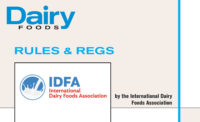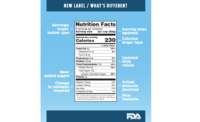Every five years the U.S. government updates its dietary recommendations, taking into account new research on nutrition, health and eating patterns. The federal Dietary Guidelines for Americans 2015-2020 released in early January supported what the dairy industry had hoped for: dairy foods are critical for a healthy diet. Americans will continue to benefit from three servings of low-fat and fat-free dairy every day.
The recommendations for healthy eating also include choosing a variety of vegetables and protein foods including lean meats, poultry, eggs, nut seeds and soy product and oils. We should select mainly whole fruits instead of juice, and get at least half of our grains from whole grains. There are limits that no more than 10% of calories should come from saturated fat or added sugars, and intake of sodium should be less than 2,300 milligrams per day.
The updated Guidelines provide information to all consumers to help them choose a healthy diet. But, the main purpose of the Dietary Guidelines issued by the Department of Health and Human Services and the Department of Agriculture is to inform the development of federal food nutrition policies and programs. These programs including the National School Breakfast and Lunch program that serves 30 million lunches to students each day.
The new report acknowledged that dairy is an under-consumed food group (see chart). It noted that dairy foods provide a valuable source of three of the four nutrients that we don’t get enough of: potassium, vitamin D and calcium.
The dairy group includes milk, lactose-reduced milk, yogurt, frozen yogurt, dairy desserts and cheeses. Cream, sour cream and cream cheese are not included due to their low calcium content.
Eat more dairy
One of the many recommendations states that Americans should shift to consume more dairy products, particularly low-fat and fat-free varieties.
It’s startling to see that almost 90% of the population isn’t eating the recommended three servings of dairy daily.
What’s even more worrisome is that while the government’s premier nutrition policy is calling for more consumption of milk and dairy, there has been a significant drop in consumption by consumers and as well in federally funded school milk programs. For example, school milk sales from the previous year dropped 5.4% in 2013 and 4.1% in 2014.
Too-strict standards
Why are government feeding programs intended to promote healthy eating unable to impact changes in what consumers eat?
Nutrition standards for federal feeding programs may be too strict. Over the past few years, changes in nutrition standards have narrowed the types of milk that can be offered. Now the choice is one 8-ounce package of low-fat or fat-free white milk. If a student prefers chocolate – and about 70% do – then the only type available to them is fat-free.
Dairy processors have done their part to help milk consumption in schools by reformulating fat-free flavored milks with less sugar and lower calories. But the reality is it’s very hard to make fat-free taste as good as low-fat chocolate milk, which is the most popular option at retail. Why shouldn’t low-fat chocolate milk be offered at schools when the Dietary Guidelines for Americans recommend choosing low-fat or fat-free dairy products?
The International Dairy Foods Association is working to raise awareness about the dramatic drop in milk consumption at schools and is urging USDA and Congress to consider policy changes that would increase milk consumption in schools.
In 2016, Congress is expected to take up legislation to reauthorize government funding for child nutrition programs. IDFA is actively working to ensure that provisions that would help correct school milk consumption declines are included in the final bill.
Now the challenge for the federal government is to do a better job of encouraging consumption. That can start in our schools.





